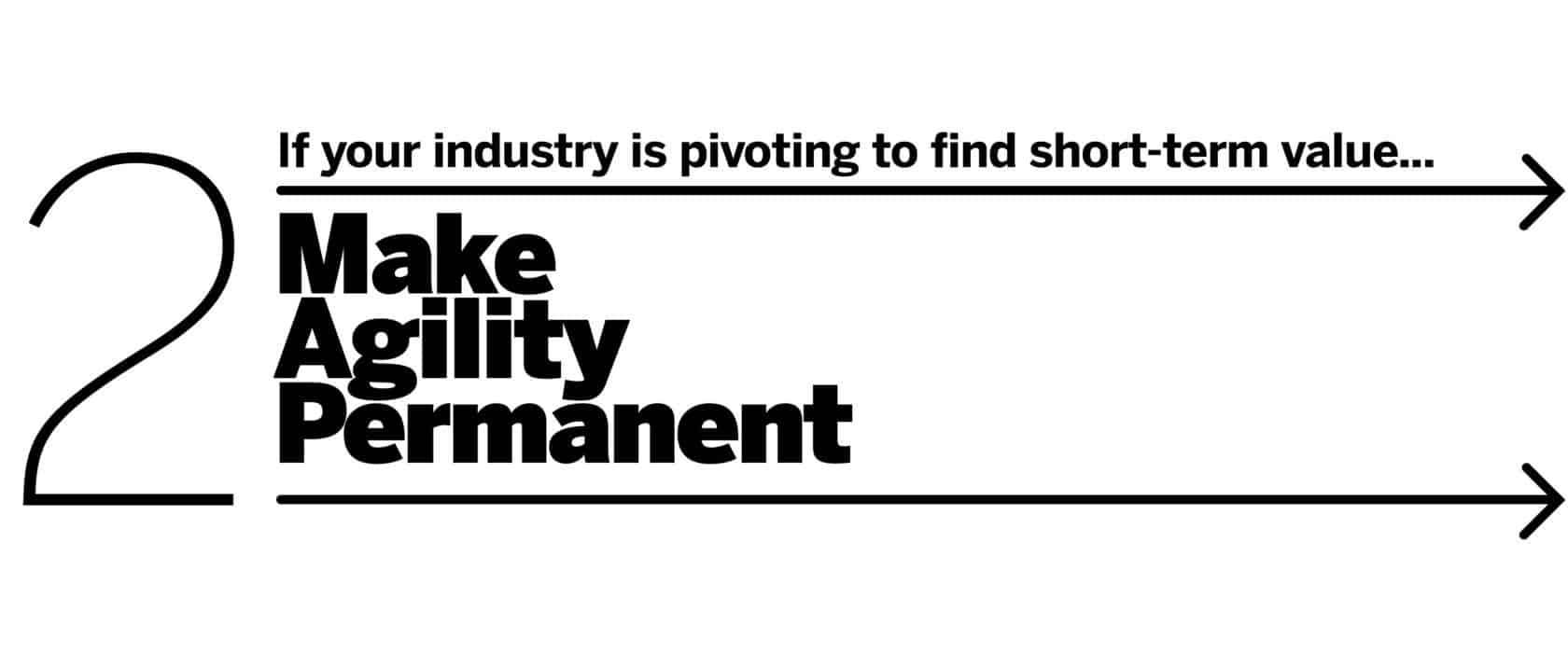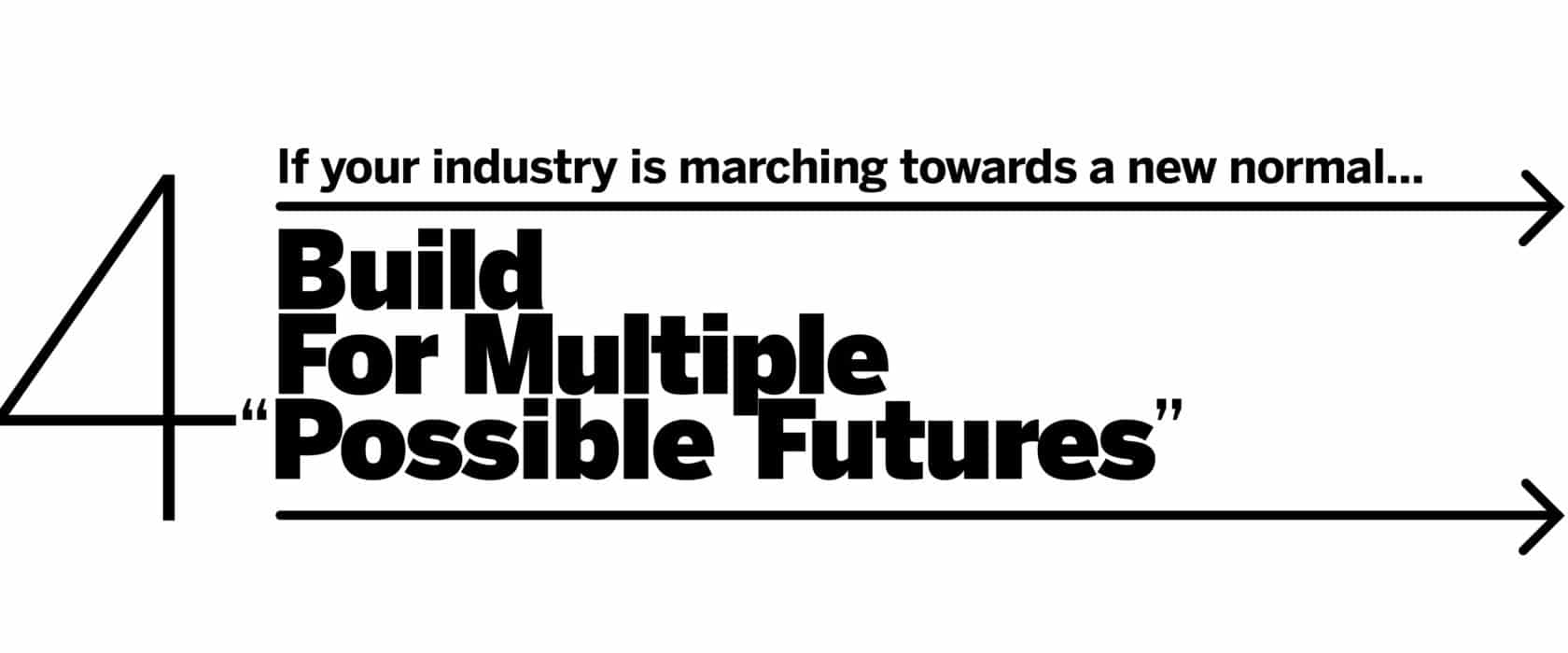Insights
You’re Adapting and Innovating Fast…Keep It That Way.

Here at IA Collaborative, we know there’s never been a more acute need for businesses to employ intense creativity to address the challenges of social distancing, rapidly evolving behaviors, and massive uncertainty.
Leaders have had to completely rethink strategies that just six months ago were the cornerstone of growth and competitive advantage. And global mega trends like experiential retail are now completely up for grabs as consumer personas based on years of data are being rebuilt.
This widespread disruption is accelerating timelines for long term transformations and forcing changes you always knew your business needed. And though innovating feels difficult when you’re fighting for survival, this crisis is an opportunity for your organization to become faster and more agile than ever before.
Over the past few weeks, we’ve synthesized 100s of hours of conversations with strategic business leaders across major industries to understand how top companies are getting ahead—and how you can achieve the same.
Inflection points accelerate inevitable behaviors
Companies and consumers are in the midst of large-scale trials and people are more open to change than ever.
These events change behavior in two key ways:
- Instant Adaptation: Instinctual actions influenced by immediate considerations and observing how others react with the hope that things will soon u-curve back to normal.
- Creation of New Rituals: When normal life is disrupted for longer periods, purposeful and informed behaviors arise in response. These new habits develop over weeks and can have lasting effects.
One of the biggest implications for innovation leaders is the need to identify which pre-crisis inevitabilities are now going to be put on the fast track. For instance, Walmart was trialing curbside pick-up pre-pandemic and expected it to account for 33% of 2020 digital sales. Today, however, first time use is up 400% and ecommerce sales are up 74%.
We’re seeing the most accelerated change in areas where shifts in consumer demand, new government regulations, and desirable corporate innovations are aligned.
The stakes are high, but so is your opportunity.
Four things future winners are doing differently
This crisis isn’t creating simple winners and losers. In fact, many companies find themselves in situations where some aspects of their business are incredibly popular while others are now untenable.
To address these challenges, all businesses are employing similar tactics: scaling to meet demand, pivoting to find short-term value, analyzing data on what’s in demand, and planning for the new normal.
But in speaking with industry leaders and partners, we found successful companies are taking a more nuanced approach to create additional value and earned advantages.
Achieving the same requires a shift in your mindset.

If your industry is scaling to meet demand…
1. Find Ways to Go Faster, Forever
Demand for your Current Offering: Up
Uncertainty: Low
Horizon: Immediate
Value: Make your company faster to respond for the long term while capturing immediate revenue
While others rush to meet demand, search for ingenious ways to harness that velocity and make it permanent. Re-examine your processes and look to maximize efficiency and produce sustainable scaling.
We’ve seen this encapsulated by leaders in grocery and delivery spaces. The closure of Wuhan, China, created a massive need for contactless delivery, so JD.com ramped up deployment of smart vehicles and worked with local officials to establish new drone routes, cutting rural delivery times from 6-hours to just 20 minutes.
Facing similar demand, Instacart expanded ordering features to offer customers more options for delivery and ordering ahead, and accelerated a data-sharing program with retailers to help prevent shelf shortages.
Your changes today could become a bigger part of tomorrow’s baseline, and customers will never be more accepting of trial-and-error.

If your industry is pivoting to find short-term value…
2. Make Agility Permanent
Demand for your Current Offering: Down
Uncertainty: Low
Horizon: Immediate
Value: Develop a culture of agility while making the most of temporary changes
Wide-scale disruption provides opportunities to reinvent old processes and unlock agility. In addition to generating short-term value, shifting resources to address current demands is a chance to reimagine your operation.
Facing shuttered theatres, Universal studios broke tradition and released Trolls World Tour digitally. The move generated more than $100 million in the first three weeks, and despite backlash from theatres, Universal committed to future digital releases, demonstrating the value of this added flexibility.
Companies have also begun experimenting with task forces, developing cross-functional teams that disrupt siloed work. These groups help businesses break free of formalized decision-making and typical hierarchies, empowering change.
Organizations now have the opportunity to document the impact of these collaborative models and uncover practices that will help prevent a retreat back to silos post-crisis.
This is a moment to redesign how we work and take positive steps toward permanent agility.

If your industry is analyzing data on what’s in demand…
3. Embrace the Rarity of “Welcome Experiments”
Demand for your Current Offering: Up
Uncertainty: Low
Horizon: Immediate & Long Term
Value: Gain strategic insight into future offerings by utilizing heightened consumer engagement
Offerings are transitioning from early adopters to mass acceptance at a wildly accelerated rate. But while others are simply studying, you can co-develop solutions and accelerate learning with engaged participants.
Change in healthcare is typically slow and incremental, but now we’re seeing years of progress on telemedicine occur in weeks. Established tools like accuRX have leveraged existing trust into wide scale adoption. Within 48 hours, the patient texting tool developed a video chat feature. This over-the-weekend experiment capitalized on an eager userbase and quickly became the standard of care for 90% of clinics in England.
United Healthcare is also experimenting with its Virtual Visits tool. First launched in October ’19, it connects remote patients with available doctors across the country. With massive disparity in patient loads and access to care nationwide, the tool is welcome relief to patients and providers alike.
With so many pockets of unprecedented enthusiasm, there’s ample opportunity for co-creation and discovery.

If your industry is marching towards a new normal…
4. Build for Multiple “Possible Futures”
Demand for your Current Offering: Any
Uncertainty: High
Horizon: Future
Value: Get ahead of your competition by gaining market info early and building future flexibility
Due to the uncertainty on the horizon, your industry may be preparing for the most likely future. But with so many variables in flux, the biggest winners will be those who plan for multiple futures and start prototyping new ventures today. This provides low-risk options for your business to hold, scale, or exit, creating maximum flexibility.
One industry working to anticipate changing needs is insurance. Predicting a growing market for identity protection, Allstate is offering free sign-ups for their multi-billion dollar app. At the same time, they’re also preparing for the future of delivery by offering delivery coverage as part of their standard car insurance.
At IA Collaborative, we create Possible Futures Playbooks, investigating industry and consumer trends to help companies uncover how to win. The residential real estate market has been highly impacted by Covid-19, with web traffic for sites like Zillow and Redfin down almost 40%. New home listings are also down 70% in some markets, and as economies reopen, we’ll see new trends emerge.
Working from home could lead to increased desire to live anywhere or move more frequently as jobs become less tied to location. Fatigue from sheltering in place could lead to higher demand for commitment-light home options, such as memberships that allow you to move from place to place. And would-be-buyers may now seek lower financial commitments, paving the way for mortgage alternatives where “rent” could be converted to lower-risk/lower return investments.
And you’re already seeing indicators of this from home sharing. In a recent interview, Airbnb CEO Brian Cheskey said, “Fewer people are going to be living in a single city. People are going to live a few months here, a few months there, because work from home can soon be work from any home.”
By taking stock of multiple futures, companies can conduct pilots to prepare for the post-pandemic future.
Securing your future
Crisis pressures can drive businesses to a place of pure reactivity, and the overwhelming needs of the moment can steal focus from the competitive challenge ahead. Finding your advantages requires a commitment to seeking opportunities.
The steps you take today will help define your organization for years to come.
Email Signup
News and Perspectives
"*" indicates required fields